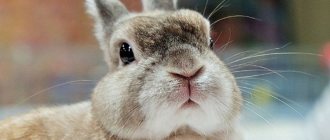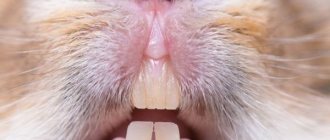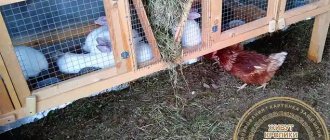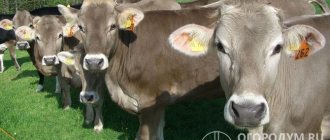Something didn't work out for me with cats. No, as a child I, of course, loved them. But as I got older, I realized that wool on the sofas, meowing in the morning and changing the litter box every day were not my thing. But children need a pet - that’s for sure! By caring for a pet, children grow up with a kinder attitude towards the world. Therefore, a search was announced for the best “family” friend without the disadvantaged features. And soon we saw a woman selling decorative rabbits. Understanding the responsibility of the acquisition, they did not make a purchase right away. We went home and started studying the topic. In this article I will tell you the advantages and disadvantages of a rabbit as a pet.
Decorative rabbit - the pros and cons of a pet
Is it worth having a rabbit in an apartment, pros or cons?
It is not human nature to listen to other people's opinions. How much did you listen to your mother, and then say, Mom, you were right, and even more so the opinion of Internet advisers on choosing animals. Meanwhile, rabbits are exotic animals for apartment keeping, and exotic animals require special knowledge. Therefore, read our advice, and then decide for yourself whether you are ready to take responsibility for a small living creature.
So, the topic of today’s review is decorative rabbits: pros and cons. How difficult is it to care for a small pet, how to feed it and what should you be wary of? Read about all this right now.
How to avoid diseases
In a greenhouse, it is impossible to achieve a level of sanitation comparable to cage housing. Feces and urine scattered throughout the area contribute to the development of coccidiosis. Therefore, animals must be given coccidiostats in a timely manner.
In winter, rabbit breeders fear frost. But he is not afraid of rabbits. And the greenhouse does not warm them, but only protects them from the wind. But due to the design features, excess moisture is created inside. Especially when there are a lot of animals. Such conditions contribute to the development of many diseases. The situation is aggravated by the evaporation of urine and the increased concentration of ammonia in the air. There must be ventilation.
When kept for walking in winter, it is better to plant only females in the greenhouse. The presence of males leads to indiscriminate mating. And if there are several of them, it leads to constant fights. Therefore, males must be left in cages.
If you spend time once and adapt the greenhouse to keep rabbits, you will get a full winter run for all subsequent years. This means you use the favorable summer time to maximize the reproduction of your herd. At the same time, after winter you get well-fertilized soil and high yields in summer.
Decorative and productive rabbits
Rabbits can be wild or domestic. Read all about wild rabbits. Domestic rabbits are divided into two types of economic use.
- Productive breeds are grown exclusively for meat, skins, and fluff.
- Decorative breeds and their varieties are dwarf and are raised only as pets.
In 1912, zoologists divided rabbits into two orders - rodents proper and lagomorphs. Since that time, rabbits, hares and pikas began to be classified as rodents (lagomorphs). So don't call rabbits rodents.
Read more: Why rabbits are not rodents
When you can’t get a decorative rabbit, pros and cons
It is strictly forbidden to purchase rabbits.
Don't get a rabbit as your first pet. Do not get a rabbit to play mother-daughter games for girls 10-12 years old. Don't let your first experience of future motherhood end with the death of your pet. The risk of death is very high. It's better to adopt a kitten from a shelter. This will be the best example of kindness for the expectant mother. Cats, physiologically, are much closer to people. They have the same type of digestion, they are smarter, communicate easier with people, and are more adequate.
Teach children responsibility and kindness, and not to fulfill the child’s every whim. Read the great Ukrainian and Russian teacher V.A. Sukhomlinsky.
Start at your discretion, but remember the characteristics of long-eared animals at home.
- Do not have pets under the influence of momentary sympathies.
- If you don’t know, the second most frequently asked question from lovers of decorative rabbits is the question in the search engine: why do rabbits smell? I’ll get ahead of myself and say that the smells are overfeeding the pet with treats.
- Not many people know that eating feces in rabbits is a physiological feature that cannot be weaned off. In all lagomorphs (lagomorphs), cecotrophy is a physiological feature of digestion. The rabbit is not a rodent; it belongs to an order parallel to rodents.
- For young families, an exception: if one of the members has been the owner of the animal for a long time. Build your relationship first.
- If you plan to have a little one. Definitely, the animal will interfere and distract the young mother from new and difficult responsibilities; do not torment the mother and the animal.
- One of the family members is against pets. Avoid unnecessary scandals with loved ones and family.
- Like a thoughtless purchase, at the child’s first request. Parents will take care, and the child, instead of kindness, will learn to shift his worries onto the shoulders of others. Or immediately take on this burden and explain to the child that this is not his whim, but the decision of the family council.
- The area of the home is so small that there is nowhere to turn around. Sometimes our housing is so small that its area resembles an enclosure for a large dog.
- Rented housing is also not an option. Rental conditions may change; constant moving does not contribute to normal conditions for the pet.
There are other options, they can be listed for a long time, based on the characteristics of each family, and determine for yourself the pros or cons of a decorative rabbit in the house. But if you are determined to get a rabbit, then read on, perhaps you will only become stronger in your desire to care for a cute bunny.
Small breeds
These small pets weigh no more than 1.5 kg and are 30 cm in length. These breeds live 6-12 years.
They do not need special care and are not picky about food. These animals are playful and cheerful. They were often kept as pets.
Angora breed
This species originated in Turkey. It was bred to produce down, which is then used to make Angora wool. The Angora rabbit is very beautiful, it can be of different colors: black, white, red, silver, chocolate.
This is a very shy animal. There is no need to make sudden movements around them. Rabbits are very friendly and playful.
They can be taught to follow simple commands, and they remember everything thanks to their intelligence.
These individuals are also distinguished by the fact that no sounds come from them; they are silent. In 1 year, a female rabbit can give birth to up to 10 cubs.
The main disadvantage is that they chew everything that gets in their way: furniture, wires.
White down
This breed was bred in Russia. Our country has long been famous for down products. It is for this purpose that the white downy individual was bred.
The animal has long and silky fur. The eyes are pink. This is a friendly and calm breed. The female bears up to 12 rabbits per year.
They grow quickly and by 2 months. the babies are starting to give off fluff. In photographs, the white fluffy bunny looks like a small ball of air.
Chinchilla rabbit
This species was bred in France to imitate the expensive fur of a chinchilla. And they achieved excellent similarity.
Our country has become very interested in this breed. But this species could not fully exist in our country due to the fact that the climate was not suitable for the individuals.
The weight of such a rabbit reaches 5 kg, body length - up to 60 cm. The offspring of females is small, about 8 rabbits. The breed is valued for its high quality skin and a fairly large amount of quality meat.
Soviet chinchilla
This is a popular breed that is bred to obtain skins and the required amount of dietary meat.
She was bred from a French rabbit and got a breed that survives well in our climate zone.
- It has a silver-blue color, and its ears and tail are black.
- The quality of the fur is valued for its thick and uniform texture.
- In the first months, rabbits grow very quickly, but later this process slows down.
- This is an unpretentious animal that does not require complex care. The main thing is to keep the cage clean and change the water. In winter, it needs to be heated, and in summer, do not place the cage in the sun.
Rabbit breed "Soviet Marder"
This breed was bred in Armenia. It got its name due to its resemblance to a marten. This species lives in the South and is a heat-loving species.
The weight is small, about 3.5 kg. And the height is up to 50 cm. Rabbits need to be fed often, with fresh food. This breed is susceptible to various diseases, especially having a weak gastrointestinal tract.
The animal is highly valued for its thick and soft dark brown fur. Female rabbits are fertile; they have up to 10 babies in their litter.
After reading the description, let's move on to the photo and look at all types of rabbits.
An animal is not a child's toy
This is the first thing to realize. Despite their miniature size and usually affectionate nature, rabbits will require attention, affection, special food, and special care products.
Dwarves are sometimes very aggressive, even more so than giants
Before you get a rabbit at home (and this must be explained to your children), you need to take care of the mandatory conditions for keeping a dwarf rabbit at home:
- spacious cage;
- the rabbit owner has free time when he needs to take his pet for a walk;
- proper nutrition and veterinary care;
Rabbits do not tolerate moving and travel well. How to transport rabbits and other animals within the country and abroad, find the section veterinary certificate form 1 veterinary Rosselkhoznadzor. It is clear that it is difficult to understand the cavalcade of documents, but find your region in the search at the top of the page of this site. If necessary, contact inspectors in your region by phone. We are obliged to help you. In any case, you will know what requirements need to be met when crossing the border with an animal and more. Perhaps the information from the site will help you make a choice when buying decorative rabbits. Rabbits can be long-haired or short-haired.
Some notes from the owners' experience
It is the reviews and experience of owners of furry animals that help them decide whether to get a rabbit or not. A few recommendations:
- when traveling with rabbits, you need to prepare the same package of documents as when transporting cats/dogs (a passport with vaccination records and a “fresh” certificate from a veterinarian are required);
- Rabbits are social animals and if the owners are constantly at work, then the animal may not fit into the family, will be scared of everyone and may even bite. Some owners note that the rabbit recognizes one owner and is reluctant to go into the arms of other people;
- If there are small active children in the family, then it is not recommended to have a small pet. You can purchase an animal for a child aged 10-13 years. Small children will not be able to seriously care for the animal and may frighten it;
- rabbits are calmer than female rabbits. Although this feature is also determined by the character of the individual. Fluffies get along well with other pets;
- owners like that the rabbits are not allowed to walk outside, and that minimal time is required for servicing the animals and cleaning the cage.
It is possible to train the animal to respond to its name and to its litter box. It is worth remembering that a rabbit is an animal that bites and is capable of throwing itself in the face. They also take into account the timid nature of animals; they should not be left alone for a long time. Cute creatures evoke affection in both children and adults. Animals require a minimum of care and always respond to affection and attention. In order for animals to fully develop, it is necessary to choose the right food and arrange a suitable place for keeping them.
Is it worth having a rabbit for children? Pros or cons?
The kids really like cute miniature creatures. However, the child needs to understand that squeezing a “living toy” will have to be done carefully. It is necessary to take into account not only the desires of the child, but also the desires of the rabbit; although he is small, he is a living creature.
The rabbit does not bite often - more often it just hits the offender hard with its hind legs
Photo. Before buying a rabbit, we present the picture like this
- At the slightest change it can become aggressive.
- Baby rabbits should be purchased only from trusted breeders, or at a pet store.
Let's sum it up
Photo from lapyhvost.umoritelno.com
We tried to touch on the main points of caring for a rabbit in this article, using basic information about their life activity, including reviews from the owners of these sweet creatures. Now you know how to properly feed, bathe, clean and walk your long-eared furbabies. If this pet appears in your home, happiness and joyful emotions are guaranteed to you. And the above is just a small compensation.
Can a decorative rabbit be huge?
It is believed that a home decorative pet must be a small animal. This is wrong. Maybe you are looking for a huge decorative rabbit. Then the old breed Flanders rabbit is your choice. The history of breeding this breed is very interesting and full of mysticism. Flandre is the largest rabbit, with an average weight of 12 kg. Flanders are common domestic rabbits in the United States that are bred as pets. In America, a program has been developed to teach children how to care for animals using the example of Flanders. The main breeds of giants, rabbit and ram, including dwarf breeds. The Rex breed group is interesting.
Pygmy fox
Origin story. The breed was developed in Austria in 1992.
Characteristic.
- Dwarf foxes are among the five smallest decorative breeds of rabbits. Their weight rarely reaches more than half a kilogram.
- The animals are normal-haired, the hair length is from 3.5 to 7 mm.
- The coat color of dwarf foxes is very diverse. But the white and red ones are most valued.
Care.
These rabbits should only be washed in extreme situations. Claws need to be sharpened 2-3 times a week. The coat should be brushed regularly.
Is it possible to teach a rabbit to pee and poop in the same place?
If the rabbit lives only in a spacious cage, then it is possible to train it, since these animals are very clean and usually choose a secluded place in their home for their excrement. The right tray is that very secluded place. However, remember, when released from the cage, he will most likely pea incessantly and this is also the norm, this is how he “confuses” his tracks from predators.
Are you ready to tolerate a poor animal for 5-7 years? If yes, then let's talk about feeding
What food does a decorative rabbit need?
The rabbit comes to the feeder very often during the day: from 20 to 60 times. No, you can fill the feeder once a day, he just needs to always have a feeder full of food. Rabbits salivate constantly, and not like other animals, before and during meals. In addition, his front teeth - incisors - are constantly growing, he needs to grind them down, or rather, he grinds them down himself when he gnaws on hard twigs. Otherwise, a disease called malocclusion develops.
The rabbit is a granivorous animal, and not a ruminant like a cow. The cow has four stomachs and can digest low-nutrient grass. A rabbit, like a cat and a dog, has only one stomach. However, in the diet of a decorative rabbit, approximately 70% of the food is hay, grass, and twigs. Grain feed in the diet of a decorative rabbit is no more than 30%. They purchase grain feed at a pet store or make their own mixtures of grains. Grain is better absorbed in crushed form; coarse grinding is required; grain ground into flour is not allowed to be given to rabbits.
Cecotrophy is a way to assimilate grass and grain as completely as possible, an analogue of ruminant rumination
Photo. But what can happen if you don’t give a decorative rabbit, for example, twig food?
Conditions of detention
To properly keep a rabbit in an apartment, you need to know certain nuances:
- cannot tolerate overheating;
- direct sunlight is harmful;
- ideal temperature - +20 °C;
- air humidity - 50%;
- they are afraid of drafts.
Keeping a decorative rabbit in an apartment requires the presence of a spacious cage or enclosure with all the necessary equipment for normal life. Read about the most popular breeds of decorative rabbits.
Why is it not recommended to keep them in cages?
For a rabbit to be healthy, movement is very important for it. A cage up to 1 meter in size cannot provide the necessary territory for active running, so the pet must be allowed out for walks, during which the animal:
- stretches paws;
- develops coordination of movements;
- reduces weight;
- receives disease prevention;
- communicates closely with the owners.
Requirements for an enclosure for rabbits in an apartment
For an active life, a rabbit needs an enclosure where it can run and jump at any time. The area of this structure must be at least 2 square meters. meters per animal. It is advisable to place the enclosure along the wall, in a place where there will be no direct sunlight and no draft.
To save space, this structure can consist of several floors. The floor of the enclosure should be soft; in order to avoid diseases of the animal’s paws, it is necessary to lay a rug made of natural material on the floor. The enclosure needs to be cleaned at least once every 7 days.
Unfortunately, rabbits often get sick, so the owner of this animal should know about common diseases of decorative rabbits.
Security measures
Keeping a dwarf rabbit at home involves protecting it from various dangers, in particular:
- All wires must be placed in boxes or raised to a height beyond the reach of the pet.
- Eliminate the possibility of going to heights.
- Put the clothes in the closet.
- Instead of newspapers and magazines, give out a cardboard box.
- Eliminate cracks behind the cabinet where a rabbit can crawl.
- The balcony door must be locked if the balcony is not glazed.
How do rabbits get along with other animals?
The question is controversial whether it is worth starting a zoo at home from different species of animals that are antagonists in nature. If you have even the slightest idea about animal psychology, start one. If you have no idea about competition in the animal world, hierarchy, who to feed first, who to feed later, who needs to be petted, who needs to be reined in. Then don't start it. Remember that keeping a rabbit at home is more difficult than keeping dogs and cats.
Photo. Oh, trouble, trouble! The owner also decided to get a rabbit. Vasya, maybe we can eat it, huh?
Is it worth getting a rabbit in a city home or apartment? If you have pets that can eat rabbits in the wild, think carefully.
For example.
- It is possible to keep a rabbit together with reptiles if snakes and other reptiles live in a secure terrarium.
- Dogs. A predator can easily provoke an “interspecies” scandal and eat the baby rabbit on the very first day of purchase. It is usually not recommended to have rabbits in homes where there are dachshunds or other dogs designed for burrowing.
- Cats. These animals are very jealous, and underneath the outward indifference and play there may be a showdown. There are known cases of cats leaving home when a competitor appears.
- Birds. Shared content is almost always allowed. Birds and rabbits are animals of different elements (heaven and earth).
What to feed a rabbit, and what is better not to give to a furry pet
Photo from the site sohabr.net
The domestic (ornamental) subspecies eats everything the same as its wild forest relative. Your pet’s diet should contain not only vegetables and herbs, but also bran, grains, and vitamin supplements.
Breeders generally feed their pets twice a day. In the morning, the menu consists mainly of dry food, and in the late afternoon vegetables, fruits, and hay. These animals are quite voracious and therefore many owners never leave the feeder empty. This kind of liberties can lead to obesity in your pet.
You can often hear a phrase related to a vegetarian table: “Some kind of rabbit food.” We are, of course, talking about vegetables and fruits. Yes, rabbits are vegetarians of the animal kingdom. And therefore, do not even think about feeding them the leftovers of your own lunch: sausages, cereals or sweets, and many others. The stop products category includes potatoes, legumes, nuts, beets, and cabbage stalks. All these products can lead to numerous illnesses for your pet: bloating, digestive disorders, etc.
Rabbit and man
Wild rabbits live in groups and do not tolerate loneliness well. This also applies to decorative rabbits. Believe it or not, it is important for your pet to feel like a member of the group. Such a group could be another rabbit, a family of people, a person. A rabbit may consider animals of other species that were raised at the same time as its family. The rabbit needs to determine its place in the pack, who to obey, who to dominate. Ignoring the animal’s innate reflexes ends in the latter’s unmotivated aggression.
Read more: Why does a rabbit bite?
At what age is it better to buy a rabbit?
- Before purchasing, you must check the age of your pet. Do not take baby rabbits immediately after weaning from their mother. The approximate age suitable for purchasing a baby rabbit is 3-4 months. This age corresponds to 10-12 years in humans.
- Until 3-4 months, all necessary vaccinations and antiparasitic treatments are given, which is mandatory for decoratively bred breeds that come into close contact with humans. Subsequent vaccinations are given or not given based on the likelihood of contact (direct or through owners) with other rabbits. Rabbit infections are specific, so contagious diseases of dogs or cats are not dangerous for rabbits.
Rabies is dangerous for rabbits only when bitten and the saliva of a sick animal gets into the wound. There is a possibility of rabbit rabies in rural areas; in the city the danger is purely hypothetical. Although, to be honest, cases of rabies in rabbits are extremely rare, more often domestic animals become infected through the bites of foxes (dogs, cats, cows).
Having figured out at what age to adopt a fluffy (or smooth-haired) pet, you need to prepare a spacious cage, a supply of food, twigs that can be chewed to grind down teeth, and a tray to which the rabbit will need to be accustomed. It is not recommended to take adult rabbits, since the animals already have established habits, and they react to shift changes with illness, depression, and even sudden death.
How to feed rabbits correctly
The domestic rabbit requires quite a lot of food due to its body structure and activity.
The lion's share of the daily diet of rabbits is food of plant origin. There are several types of food:
- greenery;
- succulent food;
- roughage;
- combined feed.
It is important to remember that for proper growth and development of pets, the rabbit menu should consist not only of all types of food, it should include vitamin and mineral supplements. To calculate how much feed you need per day, you should use the feeding rate table.
Green food includes fresh grass, cabbage leaves and vegetable tops. In summer there are no problems with obtaining this food. But what to do in winter? This is where succulent food comes to the rescue of the rabbit breeder. Root vegetables or silage are usually used as succulent additives. Silage is prepared in advance and fermented for at least 2 months.
In winter, instead of greens, the source of vitamins for rabbits is roughage. This is hay, branches and tree bark. Hay, like silage, is prepared in advance. The cut grass is carefully sorted and washed with boiled water, after which it is dried in the shade on the street or on the balcony. Branch food should also be prepared in spring or summer. Not every tree is suitable for rabbits: some of them, such as elderberry or apricot, are extremely toxic.
Combined food and fresh vegetables are considered a source of protein and fiber for rabbits. Without these products, the animal will not be able to gain weight. Concentrated feed includes hard grains such as wheat, oats, barley, and sunflower seeds. Rabbits enjoy eating corn and peas. Among vegetables, carrots and cabbage take first place, but potatoes, pumpkin, and zucchini are also suitable. Rabbits can be given beets, but in moderation. Rodents have rather weak stomachs, and things can end in frustration.
Another feature of rabbits is their teeth. The animal's incisors grow throughout its life and to prevent them from starting to curl, wood is needed for the point. Otherwise, the eared one will begin to gnaw the cage and make noise at night.
Vitamin and mineral supplements, in addition to regular food, are contained in fish oil, bone meal or chalk. These components must also be present in the animal’s diet, especially for expectant mothers. A lack of calcium can lead to rickets and bone deformation.
There are four meals a day and three meals a day, which also differ depending on the time of year. Usually, farmers select feeding times individually for the breed, but if the rabbit is a pet, then you need to feed it based on your own schedule. Food should be given at approximately the same time, otherwise the animal begins to get nervous. Even small rabbits drink a lot of water, so it is important to monitor the availability of fluids around the clock. Hunger is not as bad for this animal as dehydration. The drinking bowl is filled with plain water, but preferably settled or boiled. To boost immunity, you can add a drop of lemon juice to the water once a month.
Who to choose, boy or girl
There are pros and cons for males and females. Care and maintenance for individuals of different sexes is not particularly different. Females, like males, can write by. Rabbits mark territory. Not smelly glands on the chin, smelly glands under the tail. Friendliness and affection, as well as behavior, depend on the genetic component, and not on the sex or species difference of the animal. Raising a rabbit can be done with effort, health monitoring, and genuine friendliness, which animals pick up on.
Care
In terms of care, rabbits, compared to other pets, are quite
unpretentious. They are always clean, so there is no need to bathe them. Another reason not to bathe rabbits is that rabbit fur takes a long time to dry, which can cause the rabbit to catch a cold.
The rabbit needs to have its claws trimmed in a timely manner or taken to a special salon. Since overgrown claws can cause pain to the rabbit and even twist the fingers. It is also recommended to have your rabbit's health checked by a veterinarian in a timely manner. Particular attention should be paid to the ears, eyes and skin of the rabbit.
Remember to monitor your rabbit's health. It is very important! Proper care will preserve the health and longevity of your rabbit. After all, the average age of a rabbit is 10-15 years.
How to determine the health of a rabbit before purchasing
You need to check the condition of your future pet before purchasing. It is advisable to purchase rabbits not from hand, but from pet stores, although they can deceive you in a store. Don't trust sellers, trust your eyes. But if the animal breeder is trustworthy and can provide all the necessary documents and confirm vaccinations, listen. There is no particular reason for breeders to deceive. Once he deceives, then few people will take animals from him.
If there is no one to advise, pay attention to the following points:
- Eyes. The eyes and nose should be clean, without signs of any discharge;
- Activity. Little rabbits should be active and inquisitive, sniff and inspect the territory, and easily make contact during inspection;
- Fur. A good indicator of health is clean fur, no bald spots, bald spots, combs or scratches;
- Appetite. A good appetite for a baby rabbit is the key to health.
- Ears. The inside of the ear must be clean
I almost forgot. At the age when I advise you to buy a pet, see point 3. The rabbit sheds.
Pay attention to this, consult with the breeder, and avoid the first experience of unnecessary and useless treatment. Watch the rabbit molt. Why does hair fall out, why does one go bald.
Do not pay attention to the temperature of the rabbit's ears, dryness or wetness of the nose. If you are not a specialist in the field of veterinary medicine, you should not pay much attention to this indicator; you can easily make a mistake. Hot ears and a dry nose of a rabbit are of clinical significance if the baby has no appetite and constantly lies in the far corner of the cage.
How to choose the right one
In order not to get lost in the variety of breeds, you need to correctly determine the criteria for your choice. Find out more about the temperament of the breed you think is right for you, and also consider the costs you'll incur.
Breed selection criteria:
- degree of friendliness;
- behavior towards strangers;
- degree of daily activity;
- weight - miniature breeds should not be purchased by families with children, in order to avoid injury to the rabbit;
- disease resistance;
- need for daily care.
Ask the breeder about the breed and characteristics of the rabbits in a particular litter. While you are communicating, observe the behavior of the kids. Don't choose a pet based solely on what you know about the breed. Make sure the rabbit you choose is healthy. He must be active and energetic. The fur is shiny, without bald spots and parasites.
Important! For families with children under 13 years old, a male is more suitable
-
he is less timid than the female.
This applies to sudden outbursts of tenderness on the part of children. Run your hand over the body on both sides - you should not feel any signs of damage or swelling. Both sides of the body should feel the same to the touch.
Diseases of rabbits for which there are vaccines
To be fair, it should be noted that infectious diseases of rabbits, including decorative ones, are not fatal to humans. There are no known cases of rabies in domestic rabbits, although rabbits are susceptible to the rabies virus.
When traveling on trains and planes, anti-rabies (rabies) vaccination is mandatory.
Infection of rabbits from hunting dogs is unknown. Rabbits do not suffer from tick-borne encephalitis, Lyme borreliosis and other infections transmitted by ixodid tick bites.
When a rabbit is bitten by a tick, fatal allergic reactions are possible, but they are not infectious.
It is necessary to vaccinate an ornamental rabbit only if the animal is a breeding animal, participates in exhibitions, or the owner of the animal has contact with farm rabbits.
It makes no sense to vaccinate a rabbit living in a metropolis where there is no contact with other susceptible relatives.
Vaccines against the following diseases have been developed for rabbits:
- myxomatosis is an infection transmitted by mosquitoes, dangerous in rural areas where there are rabbit farms, people do not get sick;
- rabbit viral hemorrhagic disease (RVHD), sometimes called rabbit distemper, does not affect people;
- lichen (dermatophytosis), rabbits and people get sick.
- pasteurellosis in rabbits, people get sick.
Typically, complex vaccines are used for rabbits, which contain protective antigens against all diseases. Sometimes I use vaccines against one or two infections. Your veterinarian will tell you the pros and cons of each vaccine for your animal.
Contagious diseases of rabbits for which there are no vaccines
- Coccidiosis is a parasitic disease caused by microscopic parasites that inhabit the intestines and liver. There is no vaccine. Treated with chemicals, instructions for veterinary medications in packaging convenient for decorative rabbits.
- Rabbit worms. Helminths are more common in rabbits in rural areas. One treatment is enough, upon purchase. Then repeat only if there have been contacts with other rabbits (other animals do not get sick). Parasites of cats and dogs are not dangerous for rabbits, since rabbits do not suffer from meat-eater diseases.
- Tick-borne diseases of rabbits. There are two known diseases. The first ear mite is called “Psoroptosis” - microscopic mites in the ear, mainly in young animals, transmitted from the mother. The second is called “Cheyletiosis” - mites on the body - redness and thickening of the skin on the neck. Both diseases are easily treated. Not dangerous for people.











